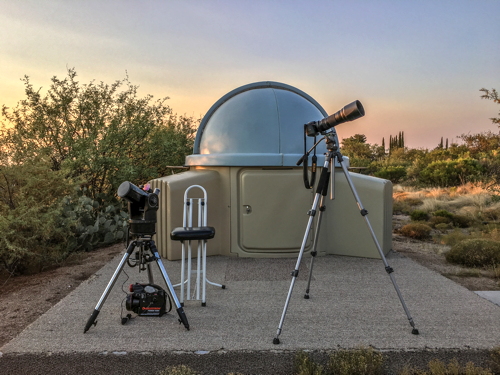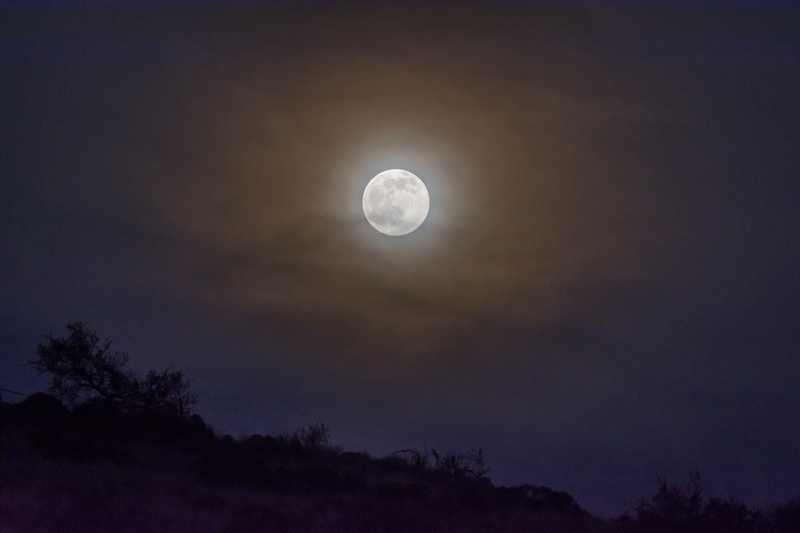DSLR: Setting Sun, nearly Full Moon;
ETX-105PE Observing: Jupiter, Mars, Saturn
Posted: 20 June 2016
The Brown Fire continued to burn in the Baboquiviri Mountains about 70 miles southwest of Cassiopeia Observatory. After sunrise on Sunday, 19 June, there was a lot of smoke visible along the western horizon, as seen in this webcam image.

This image from a Kitt Peak National Observatory webcam really showed the smoke on the mountain Sunday morning:

 The mountain was not visible from Oracle Sunday morning as there was too much smoke obscuring it. The sky here was hazy in the afternoon, probably from the smoke from the Brown Fire.
The mountain was not visible from Oracle Sunday morning as there was too much smoke obscuring it. The sky here was hazy in the afternoon, probably from the smoke from the Brown Fire.
It was rather warm in Oracle on Sunday. At the right is the outside air temperature and humidity at 1500 MST at Cassiopeia Observatory.
|
Open: Sunday, 19 June 2016, 1900 MST Temperature: 102°F |
Session: 988 Conditions: Mostly clear, hazy/smokey |
Equipment Used:
ETX-105PE
AutoStar #497 handset
1.25" 26mm eyepiece
1.25" 3X TeleXtender
Camera:
D7200 DSLR
Set up the ETX-105PE on the observatory patio. I also set up the D7200 DSLR with 150-600mm lens on a camera tripod. Here they are, with some of the smokey sky visible behind the observatory about 26 minutes before sunset:

When I completed setting up I noticed that there were some clouds appearing in the east-to-south sky.
As sunset approached I moved the DSLR and tripod to a higher location to photograph the Sun setting behind distant mountains. Here are two cropped images taken at a focal length of 600mm, f/11, 1/8000sec, ISO 1000, and f/16, 1/6400sec, ISO 640:


1938 MST: sunset.
Returned to the observatory patio. The clouds in the east/south were higher in the sky now.
1950 MST: ETX-105PE ON. Faked the star alignment, but did SYNC the AutoStar on the star Spica. Viewed Jupiter, 56X. The four Galilean Moons were nicely distributed on both sides of the planet's disk. Added the 3X TeleXtender and viewed Jupiter, 170X. Good view of the planet.
2006 MST: the nearly full Moon began rising over the hill to the southeast, but it was in the clouds.
Viewed Mars, 170X. Seeing was not good due to the clouds, but at times some details were visible.
Then viewed Saturn, 170X and 56X, through a hole in the clouds. The view was OK but not great due to thin clouds partially obscuring the view.
Using the D7200 DSLR and 150-600mm lens I took this photograph (cropped) of the nearly full Moon through the thin clouds, f/6.3, 1/125sec, ISO 400, FL 600mm, showing a very slight terminator at 4-5 o'clock:

This is how the Moon and clouds appeared over the hill to the southeast, f/6.3, 1/20sec, ISO 400, FL 220mm:

2020 MST: returned to the ETX-105PE and slewed it to the star Polaris to do a TRAIN DRIVES on the AutoStar. At least, that was the plan. Unfortunately, I kept getting a "Motor Unit Fault" error as the telescope was slewing. Apparently the external battery I was using was too weak now. (The battery had been used for several sessions without a charge.) Since the cloud cover was increasing I decided to not bother using a different power source and I began closing up for the night.
|
Close: Sunday, 19 June 2016, 2041 MST Temperature: 86°F |
Session Length: 1h 41m Conditions: Partly cloudy |
Comments are welcome using Email. Twitter users can use the button below to tweet this report to your followers. Thanks.
Cassiopeia Observatory Home Page
Copyright ©2016 Michael L. Weasner / mweasner@me.com
URL = http://www.weasner.com/co/Reports/2016/06/20/index.html
